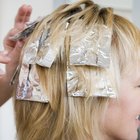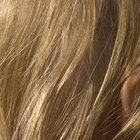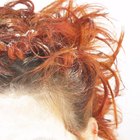If you're looking for a hair color pick-me-up, the options can be overwhelming. From a double process to streaks, hair color often needs a little bit of explanation. Highlights and glaze are popular options for a light or dramatic change.
Highlights
Highlights are created when a lighter color or bleach is applied to selected strands woven through the hair. When darker color is applied, it is commonly called "lowlights."
Glaze
A glaze is a clear or tinted top coat for the hair that can be used to add a slight color, though in clear form it is used for conditioning and shine enhancement. Glaze is typically a semi-permanent color that does not lift the underlying hair color.
Highlight Styles
When weaving in highlights, there are several options from selecting large chunks or panels, to creating thin streaks. For the most natural looks, highlights are blended by selecting every other strand in a section for color application.
Glaze Types
When glaze is used for conditioning and shine, the formula is clear and slightly foamy. For color applications, glaze is used to tint the color of the underlying hair and is often known as "toner" when used as the final color in a double process.
Length of Wear
Many highlights are permanent, though new growth will need to be retouched every 6-8 weeks. Glaze is semi-permanent, and the fade of the treatment depends on how often the hair is washed and conditioned, along with external issues such as environment.
In Tandem
When highlights are applied, many stylists will apply a toner to the highlighted sections of hair to tweak or refine the color. A glaze also creates "highlights" when a tint is applied to dark hair, allowing for a colorful shimmer in different lighting.
Related Articles

Are Foil or Cap Highlights Better?

How to Glaze Gray Hair

Types of Afros

How to Use a Toner When Coloring Hair

What Is the Difference Between Hair ...

Difference Between Permanent Hair Color ...

What Is Clear Matrix Color Sync?

Types of Hair Dye Jobs

How to Strip a Black Rinse for African ...

How Are Highlights Done in a Salon?

How to Highlight the Crown of Your Hair

How to Color Auburn Hair Dark Brown

How to Lighten Hair Color With Jazzing

Instructions for How to Use a Wella ...

How to Blend Hair Extensions With Two ...

Bleaching Gray Hair

How to Use Goldwell Highlift 12-Series

How to Make a Riflessi Color Renewal ...

How to Partially Dye Hair

Hair Color Rinse Vs. Hair Color Dying
References
Writer Bio
Jennifer Van Leigh began writing short pieces in 2007. With over five years in the hair industry, Van Leigh has contributed articles at Atlanta Salon & Spa and is certified as an extensions stylist. She studied scriptwriting and creative nonfiction in Gallery 37, a Chicago youth arts program.